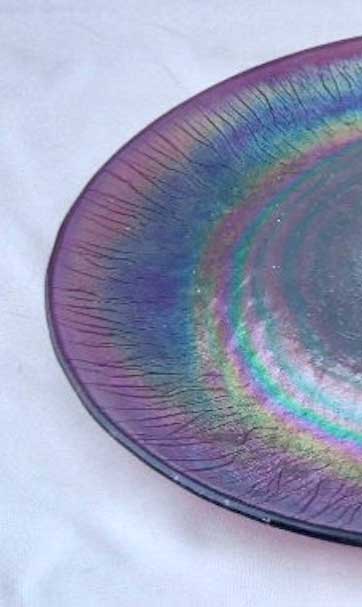February 2024
Good Eye
Celebrating American Stretch Glass
by Peggy Whiteneck
This year, the American Stretch Glass Society celebrates its 50th anniversary (stretchglasssociety.org). The group holds an annual convention and show, this year scheduled for Aug. 15-17 at Comfort Inn in Denver, PA, the place where the Society was founded. It also holds regular educational programs via Zoom on various stretch glass topics, makers, and types. Log on to its web site and check it out!
On this golden anniversary year for the Stretch Glass Society, I thought stretch glass would be a great topic for my regular “Good Eye” column this month. Although the very first stretch glass was produced in lamp shade forms in 1912, this glass type didn’t become available in a variety of other forms until 1916. Some of those forms included bowls, vases, plates, candlesticks, beverage sets, and perfume bottles (Plates were made starting with a basic vase shape and then flattening it out). Early stretch glass is distinguished from other Depression era glass by its lengthier and more complicated two-stage production process.
Stretch glass was produced by spraying a metallic salt mix on the glass while it was still hot and then reheating and reshaping (stretching) it, which caused thousands of minute striations, most visible on the edge or lip of the form. This glass was made in pressed or mould-blown patterns that are usually (though not always) undecorated and un-patterned. American Stretch glass is no longer being produced, so examples today can only be found at auction, in antique shops, or elsewhere on the secondary market.
Stretch glass was produced by several companies, at least some of which will be familiar to readers of this column: Central Glass Works (Wheeling, WV); Diamond Glass-Ware Co. (Indiana, PA); Fenton Art Glass Co. (Williamstown, WV); Imperial Glass Co. (Bellaire, OH); Jeannette Glass Co. (Jeannette, PA); Lancaster Glass Co. (Lancaster, OH); H. Northwood & Co. (Wheeling, WV); United States Glass (Pittsburgh, PA); and Vineyard Flint Glass Works (Vineland, NJ). Some of these ceased glass production earlier than others; Northwood, for example, closed in 1925.
When seen in the wild, many of the forms of stretch glass made by different companies look so similar that specific manufacturers can be difficult to tag. For example, Fenton, Northwood, and Cambridge all made a very similar tall, footed candy jar, in a style sometimes referred to as “Colonial,” which are only subtly distinguishable from one another. The diagnostic difference between Fenton jars and the nearly identical ones made by Northwood are that Fenton has a straight lid lip while Northwood’s is indented at the top of the lip and has a cover mould seam on the right of the raised ray that appears left of the ray on Northwood. Those made by Cambridge are distinguishable by two narrow rings just above the panels and lack the ribs between panels that are found in the Fenton and Northwood examples. Early Fenton examples of this candy jar were done in stretch glass.
While most stretch glass colors were in clear, iridized form, US Glass made some opaque examples, with lesser quantities and types of opaque stretch also made by Northwood. It’s sometimes difficult to see the stretch effect in these opaque forms.

American Stretch Glass
A closeup of the edge of a stretch glass item showing the striations that are the defining characteristic of this glass whatever the manufacturer. In some stretch glass examples, the effect will be more muted than it is here. (Image courtesy of the author)
Stretch glass production ceased altogether in the 1930s as companies sought simpler production processes (Fenton, however, picked up stretch production again around 1970 and produced it till around 2010, a year before the company closed). Colors in stretch glass by its various manufacturers were deliciously myriad, whether production was early or late. Because the production years of most stretch glass spanned the teens through the ‘30s decades of the 20th century, it is sometimes included in discussions of Depression glass. However, its forms and production processes make stretch glass a unique form in comparison to the less expensive and more easily produced patterned glass made by a variety of companies in the Depression era.
Peggy Whiteneck is a writer, collector, and dealer living in East Randolph, VT. If you would like to suggest a subject that she can address in her column, email her at allwritealready2000@gmail.com.

